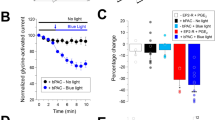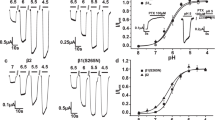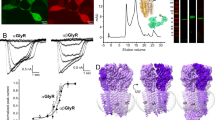Abstract
GLYCINE is an important inhibitory transmitter in the brainstem and spinal cord1,2. In the trigeminal subnucleus caudalis (medullary dorsal horn) and in the spinal dorsal horn (the relaying centres for processing pain and sensory information3–5), glycine inhibits the glutamate-evoked depolarization and depresses firing of neurons6. The binding of glycine to its receptor produces a large increase in Cl− conductance, which causes membrane hyper-polarization7. The selectivity and gating properties of glycine receptor channels have been well characterized8; the glycine receptor molecules have also been purified9–11. The amino-acid sequence, deduced from complementary DNA clones encoding one of the peptides (the 48K subunit)12, shows significant homology with γ-aminobutyric acid A (GABAA) and nicotinic acetylcholine receptor subunits, suggesting that glycine receptors may belong to a superfamily of chemically gated channel proteins12,13. However, very little is known about the modulation of glycine receptor channels. We have investigated the regulation of strychnine-sensitive glycine receptor channels by cyclic AMP-dependent protein kinase in neurons isolated from spinal trigeminal nucleus of rat and report here that the protein kinase A dramatically increased the glycine-induced Cl− currents by increasing the probability of the channel openings. GS protein, which is sensitive to cholera toxin, was involved in the modulation.
This is a preview of subscription content, access via your institution
Access options
Subscribe to this journal
Receive 51 print issues and online access
$199.00 per year
only $3.90 per issue
Buy this article
- Purchase on Springer Link
- Instant access to full article PDF
Prices may be subject to local taxes which are calculated during checkout
Similar content being viewed by others
References
Curtis, D. R., Hosli, L. & Johnston, G. A. R. Nature 215, 1502–1503 (1967).
Curtis, D. R., Duggan, A. W. & Johnston, G. A. R. Brain Res. 14, 759–762 (1967).
Sessle, B. J., Hu, J. W., Dubner, R. & Lucier, G. E. J. Neurophysiol. 45, 193–207 (1981).
Dubner, R. & Bennett, G. J. A. Rev. Neurosci. 6, 381–418 (1983).
Hu, J. W. & Sessle, B. J. J. Neurophysiol. 52, 39–53 (1984).
Willcockson, W. S., Chung, J. M., Hori, Y., Lee, K. H. & Willis, W. D. J. Neurosci. 4, 732–740 (1984).
Barker, J. L. & Nicoll, R. A. J. Physiol., Lond. 228, 259–277 (1973).
Bormann, J., Hamill, O. P. & Sakmann, B. J. Physiol., Lond. 385, 243–286 (1987).
Pfeiffer, F., Graham, D. & Betz, H. J. biol. Chem. 257, 9389–9393 (1982).
Graham, D., Pfeiffer, F. & Betz, H. Biol. Chem. 24, 990–994 (1985).
Betz, H. & Becker, C.-M. Neurochem. Int. 13, 137–146 (1988).
Grenningloh, G. et al. Nature 328, 215–220 (1987).
Grenningloh, G. et al. Nature 330, 25–26 (1987).
Stelzer, A., Kay, A. R. & Wong, R. S. Science 241, 339–341 (1988).
Basbaum, A. I. & Fields, H. L. A. Rev. Neurosci. 7, 309–338 (1984).
Westlund, K. N. & Coulter, J. D. Brain Res. Rev. 2, 235–264 (1980).
Yash, T. L. & Reddy, S. V. R. Anesthesiology 54, 451–467 (1981).
Yezierski, R. P., Wilcox, T. K. & Willis, W. D. J. Pharmac. exp. Ther. 220, 266–277 (1982).
Westlund, K. N., Bowker, R. W., Ziegler, M. G. & Coulter, J. D. Brain Res. 292, 1–16 (1984).
Duggan, A. W. Phil. Trans R. Soc. B 308, 375–391 (1985).
Fleetwood-Walker, S., Mitchell, R., Hope, P., Molony, V. & Iggo, A. Brain Res. 334, 243–254 (1985).
McGeer, P. L., Eccles, J. C. & McGeer, E. G. in Molecular Neurobiology of the Mammalian Brain 149–173 (Plenum, New York, 1987).
Huang, L.-Y. M. J. Physiol., Lond. 411, 161–177 (1989).
Hamill, O., Marty, A., Neher, E., Sakmann, B. & Sigworth, F. J. Pflugers Arch. ges Physiol. 391, 85–100 (1981).
O'Dell, T. J. & Christensen, B. N. J. Neurophysiol. 61, 162–172 (1989).
Kurachi, Y., Nakajama, T. & Sugimoto, T. Pflugers Arch. ges. Physiol. 407, 264–274 (1986).
Author information
Authors and Affiliations
Rights and permissions
About this article
Cite this article
Song, Y., Huang, LY. Modulation of glycine receptor chloride channels by cAMP-dependent protein kinase in spinal trigeminal neurons. Nature 348, 242–245 (1990). https://doi.org/10.1038/348242a0
Received:
Accepted:
Issue Date:
DOI: https://doi.org/10.1038/348242a0
This article is cited by
-
Long-term potentiation of glycinergic synapses by semi-natural stimulation patterns during tonotopic map refinement
Scientific Reports (2020)
-
Neurobeachin Regulates Glutamate- and GABA-Receptor Targeting to Synapses via Distinct Pathways
Molecular Neurobiology (2016)
-
Molecular Physiology of Glycine Receptors in Vertebrate Nervous Systems
Neuroscience and Behavioral Physiology (2015)
-
Modulation of glycine-activated ion channel function by G-protein βγ subunits
Nature Neuroscience (2003)
-
Enhancement of glycine receptor function by ethanol: role of phosphorylation
British Journal of Pharmacology (1998)
Comments
By submitting a comment you agree to abide by our Terms and Community Guidelines. If you find something abusive or that does not comply with our terms or guidelines please flag it as inappropriate.



